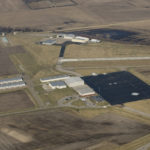Lawrence airport undergoing safety study for skydiving

This file photo from March 2009 shows the Lawrence Municipal Airport from the southeast looking northwest.
The city has taken a step forward in learning whether it’s safe to allow skydiving at the Lawrence Municipal Airport, a question that’s been brought up over the past year after multiple requests from local and regional parachutists.
Commissioner Matthew Herbert, who had heard complaints about delays from one skydiver, prompted the city in November to expedite the process.
One parachutist who made a request to use the airport as a drop zone has said the city was “foot-dragging,” and an official with the United States Parachute Association said Lawrence was an “extreme case” when it came to delays and concerns about the sport.
Interim City Manager Diane Stoddard reported to the City Commission on Tuesday that the city has been working with the Federal Aviation Administration. She said the FAA’s Kansas City office sent a letter Jan. 5 to the Flight Standards District Office in Wichita requesting a safety study.
Airport safety studies typically examine air traffic patterns, types of aircraft using the airspace, and frequency of use, said Elizabeth Isham Cory, a public affairs official with the FAA, via email.
In the letter, Jim Johnson, manager of the FAA’s airports division in the central region, also asked that the findings from the study include guidance on where parachutists should land. He wrote that city officials had expressed concern that skydiving would delay the emergency response time of Life Star of Kansas and asked that the air ambulance operation be taken into consideration in the study.
Concerns
Though the FAA is tasked with making sure all aircraft using an airport can do so safely, the FAA does not regulate parachuting, Cory said. The sport is self-regulated by the United States Parachute Association.
Gary Peek is the director of the central region of the U.S. Parachute Association and is in charge of a five-state area comprising Nebraska, Kansas, Missouri, Iowa and Illinois.
Peek said he’s talked to at least two of the people who have made requests to use the Lawrence airport. Officials at many airports have some concern with the sport, Peek said, but when it came to delays in responding to requests and the level of concern, Lawrence is severe.
“Sometimes these things happen, and we just don’t know why people are so dead set against skydiving,” Peek said. “Skydiving generally generates a lot of objection from airports, and this one is pretty extreme.”
About the city’s concerns with skydiving affecting air ambulance operations, Peek said that response, too, was “extreme.”
“When it gets all solved, it turns out they don’t (have a negative effect), but people imagine they do,” Peek said.
He used the Hannibal, Mo., Regional Airport as an example, saying it houses both parachute landing areas and an air ambulance operation.
“It’s just not a problem,” he said.
Recent requests
City Public Works Director Chuck Soules said there were six requests in 2015 to use the airport as a skydiving drop zone.
Prior to that, skydiving operator and Lawrence resident William McCauley had made multiple requests, the most recent of which was in April 2014, McCauley said.
One request in 2015 came from Paul Fortier, a skydiving hobbyist from Omaha, Neb.
Fortier said he and a group of friends regularly fly past Lawrence on the way to other drop zones in the Midwest, and they sought to use the airport because of its location and convenience.
According to copies of emails provided by Fortier, his first request was emailed to the city June 12, and he was told more than a month later the request was being reviewed. Fortier followed up Aug. 1, saying in an email that “normally this type of request moves much more rapidly — sometimes minutes, more often hours, seldom days, and I’ve never seen durations in weeks or months.”
The city responded again Aug. 10 saying the airport was working with the FAA, and Fortier wrote back again Oct. 1 but didn’t receive a response.
“It’s just foot-dragging,” Fortier said in a November interview. “It’s been a little bit of an exercise in frustration. If it wasn’t for the foot-dragging, and if they’d been reasonable in talking to me, I would have dropped the whole thing. … I’ve flown right over Lawrence, and I’ll refuel at other airports on purpose because I won’t spend money where I’m not welcome.”
Soules has said there had not been a decision on skydiving operations at the airport because of concerns for safety.
That safety study is currently in progress, Cory said. She said via email there was no estimate of when the study would be complete, only that “studies take as long as they need to in order to fully examine all of the airspace components.”
Johnson’s letter asks that the Wichita office let Lawrence officials know whether certain airport or air-traffic provisions need to be implemented to keep the area safe during skydiving operations.






